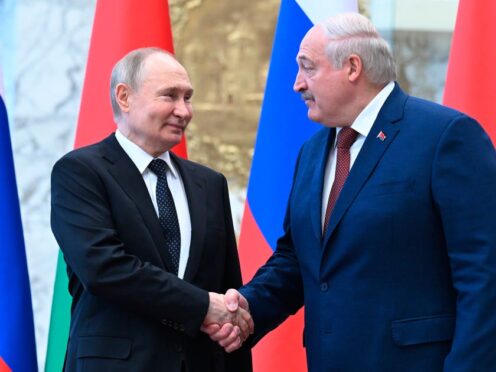Russian President Vladimir Putin visited his Belarusian counterpart and close ally for talks on Friday in Minsk, after which he questioned whether Volodymyr Zelensky has the legitimacy to negotiate on Ukraine’s behalf.
Russia is willing to hold talks about the war in Ukraine, Mr Putin said, but Mr Zelensky’s five-year term in office was supposed to end on May 20.
However, Mr Zelensky has ruled out holding new presidential elections while his country is at war — something Mr Putin apparently ignored in remarks to reporters.
Ukrainian legislation bans elections during martial law that has been in place since Russia launched its invasion in February 2022. The country would have to amend the law to elections during a state of war.
Russian officials have repeatedly called attention to the question of Mr Zelensky’s term in office during the past week.
“Of course, we are aware that the legitimacy of the current head of state has ended,” Mr Putin said at a news conference in Minsk after talks with Belarusian President Alexander Lukashenko.
“We must be completely sure that we are dealing with legitimate authorities,” said Mr Putin, who has repeatedly stated that Russia is ready for talks with Ukraine.
However, Mr Zelensky has rejected the preconditions that Russia has put forth for talks, including allowing Russia to retain the territory Kremlin’s forces have taken since the February 2022 invasion.
An international peace conference on Ukraine is to be held in Switzerland in June, but Russia has not been not invited and Mr Putin has dismissed the conference’s importance.

The two-day visit to Belarus was one of several foreign tours Mr Putin used to kick off his fifth term in office. Since his May 7 inauguration, he has also gone to China and is expected in Uzbekistan on Sunday.
Russia and Belarus have increasingly close relations and foresee eventually forming a so-called “union state”.
Mr Lukashenko has given Moscow permission to deploy Russian tactical nuclear weapons and troops to in Belarus, which shares a 1,084-km (673-mile) border with Ukraine. In 2023, Russia moved some of its tactical nuclear weapons to Belarus.
Unlike nuclear-tipped intercontinental ballistic missiles that can destroy entire cities, tactical nuclear weapons intended for use against troops on the battlefield are less powerful. Such weapons include aerial bombs, warheads for short-range missiles and artillery munitions.
Deploying tactical nuclear weapons to Belarus would allow Russian aircraft and missiles to reach potential targets in Ukraine more easily and quickly if Moscow decides to use them. It also extends Russia’s capability to target several Nato allies in Eastern and Central Europe.
Russia has also used Belarus, which depends on Russian loans and cheap energy, as a staging ground in the war in Ukraine, deploying some of its troops there.
The two countries kicked off military drills involving tactical nuclear weapons earlier this month.
Moscow said its drills, announced publicly for the first time on May 6, were a response to statements by Western officials signaling possibly deeper involvement in the war in Ukraine. The drills began this week.
Belarus launched its manoeuvres involving missiles and warplanes capable of carrying tactical nuclear weapons on May 7.
